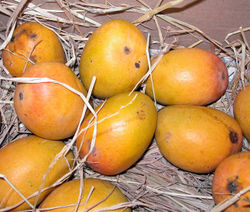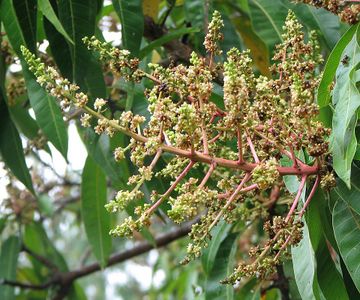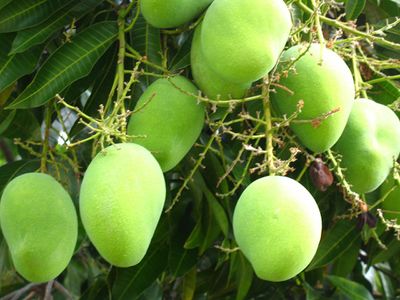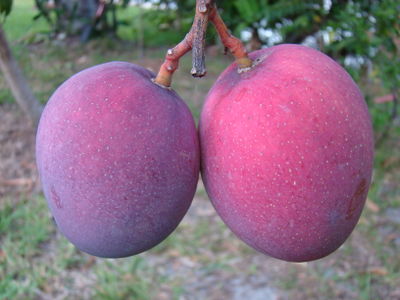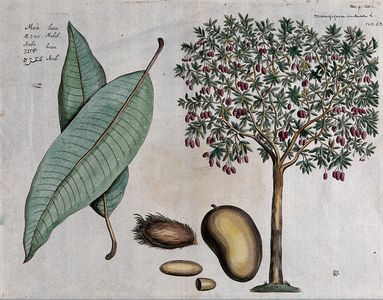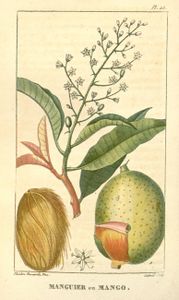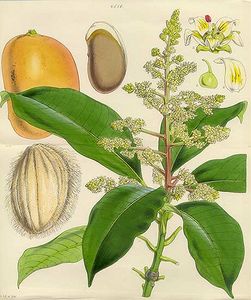Mangifera indica
Mangifera indica L.
| Ordre | Sapindales |
|---|---|
| Famille | Anacardiaceae |
| Genre | Mangifera |
2n = 40
Origine : nord de l'Inde, Birmanie
sauvage ou cultivé
| Français | manguier / mangue |
|---|---|
| Anglais | mango |
- fruit consommé mûr ou vert
- fruit transformé en jus, chutneys...
- huile des graines : substitut du beurre de cacao
- bois d'œuvre, bois de feu
- médicinal : écorce, feuilles, fruits, fleurs, racine, résine
- ornemental
- feuilles, fruit et sous-produits : fourrage
- écorce riche en tanin et résine : teinture
Sommaire
Description
Noms populaires
| français | manguier / mangue |
| anglais | mango |
| allemand | Mango |
| néerlandais | mango |
| italien | mango |
| espagnol | mango |
| portugais | mangueira / manga |
| créole guyanais | mangue [mang], pied mangue [pjé-mang] (Pharma. Guyane) |
| wayãpi | mã (Pharma. Guyane) |
| palikur | mã (Pharma. Guyane) |
| sanscrit | आम्र - āmra, माकन्द - mākanda |
| hindi | आम - ām (Flowers of India) |
| marathi | अंबा - amba (Flowers of India) |
| gujerati | આંબો - aambo (Flowers of India) |
| konkani | आंबॉ - ambo (Flowers of India) |
| telugu | mamidi (Flowers of India) |
| tamoul | மா - ma (Flowers of India) |
| kannada | ಮಾ - maa, ಮಾವು - maavu, ಮಾವಿನ ಮರ - maavina mara (Flowers of India) |
| malayalam | mau (arbre) ; mangga (fruit) (Flowers of India) |
| manipuri | ꯍꯩꯅꯧ - heinou (Flowers of India) |
| mizo | theihai (Flowers of India) |
| angami | merosi (Flowers of India) |
| Philippines | mangga (tagalog), paho (bisaya), mango (ilokano) (PROSEA) |
| Indonésie | mangga, mempelam (PROSEA) |
| Malaysia | mangga, mempelam, ampelam (PROSEA) |
| Papouasie-Nouvelle-Guinée | mango (pidgin) (PROSEA) |
| Thaïlande | mamuang (PROSEA) |
| Vietnam | xoài (PROSEA) |
| Laos | mwàngx (PROSEA) |
| Cambodge | svaay (PROSEA) |
| Birmanie | tharyetthi, thayet thayt-hypu (PROSEA) |
Classification
Mangifera indica L. (1753)
Cultivars
Histoire
Michał Boym, 1656. Flora Sinensis
mau, Rheede, Hortus Malabaricus, 1683, vol. 4:1-4, tab. 1
- Jean de Marignolli, XIVe siècle, Du jardin d'Adam et de ses fruits (Chronicon Bohemorum) sur Pl@ntUse.
Usages
Surtout charbon et bois de chauffage mais aussi meubles (DUSS) ; bois peu durable. Fruit comestible : confitures, marmelades ; consommé vert avec du sel et du vinaigre : antiscorbutique. Propagation par greffe (DESCOURTILZ). C’est probablement avec la banane le fruit tropical le plus consommé. Écorce antidysentérique. Feuilles en infusion contre la grippe (HONYCHURCH), pectorale, vermifuge, sudorifique, antiscorbutique, antirhumatismale (MARTIN & RUBERTÉ), contre la goutte (CABRE), contre les maux de cœur. Mellifère (QUESTEL). Arbre ornemental d’alignement et d’ombrage (inconvénient par l’abondance et la chute des fruits).
One of the most important and most delicious tropical fruits. Cultivated in India obviously since more than 4.000 years; now in more than 1.000 cultivars (mostly clones) in all countries of the tropics. Largest areas of cultivation are in India (60% of the fruit tree area), Indonesia, Philippines, USA (Florida, Hawaii), Mexico, Brazil, S and E Africa, Australia. The juicy and sweet ripe fruits are used as table fruit, for making juice, tarts, jams, jellies, ice-cream and preserves; unripe fruits are used in pickles and chutneys. They are rich in vitamin A and C. Fruits, leaves, flowers, roots, bark and resin have a medicinal importance. The bark contains 78% resin and 17% tannic acid and serves to dye yellow cotton, wool and silk. Domestication took place in India, the tree was distributed already BC eastwards, but much later to E and W Africa; from here it was introduced into tropical America (firstly grown in the West Indies). Human selection favoured succulence, low fibre and resin content of the fruits and small stones. Often un-improved seedlings are grown, but more recently mostly selected vegetatively propagated clones. Breeding work began in India in the early 20th cent.
Références
- Bekele-Tesemma, Azene, 2007. Useful trees and shrubs for Ethiopia. Identification, propagation and management for 17 agroclimatic zones. Nairobi, ICRAF - RELMA. 550 p. (Technical Manual 6). Voir l'article
- Boym, Michał, 1696. Flora Sinensis. Paris, 15 p. Seconde édition en français. Voir Manko sur Pl@ntUse.
- Chauvet, Michel, 2018. Encyclopédie des plantes alimentaires. Paris, Belin. 880 p. (p. 54)
- Elevitch, Craig (ed.), 2006. Traditional Trees of Pacific Islands: their culture, environment, and use. Holualoa, Hawai'i, Permanent Agriculture Resources. 816 p. Agroforestry télécharger le pdf
- Grenand, Pierre, Moretti, Christian, Jacquemin, Henri & Prévost, Marie-Françoise, 2004. Pharmacopées traditionnelles en Guyane. Créoles, Wayãpi, Palikur. 2e édition revue et complétée. Paris, IRD. 816 p. (1ère éd.: 1987). Voir sur Pl@ntUse.
- Rollet, Bernard et coll., 2010. Arbres des Petites Antilles. Tome 1 : Introduction à la dendrologie. 276 p. Tome 2 : Description des espèces. 866 p. + 46 pl. coul. + CD de photos sur l'anatomie du bois. Basse-Terre, ONF. sur Pl@ntUse.
- TRAMIL, Pharmacopée végétale caribéenne, éd. scient. L. Germosén-Robineau. 2014. 3e éd. Santo Domingo, Canopé de Guadeloupe. 420 p. Voir sur Pl@ntUse
